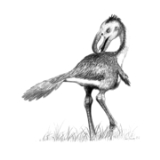
Cariamae
Encyclopedia
Cariamae is a suggested name for a group of primarily flightless birds that have been around for 63 million years. The group includes the families Cariamidae, Phorusrhacidae
, Bathornithidae, Idiornithidae and Ameghinornithidae. Though traditionally considered as a suborder of the Gruiformes
, based on both morphological and genetic studies they may belong to a separate group of birds whose other living members would be the Falconidae
, the Psittaciformes and the Passeriformes.
The earliest known fossil belonging to this group is an isolated femur
from the Cape Lamb Member of the Lopez de Bertodano Formation
, Vega Island
, Antarctica. This specimen, which dates to the late Cretaceous
period about 65 million years ago, is identical to the femurs of modern seriema
s, and belonged to a large bird about 1 metres (3.3 ft) tall. Because of its age and geographic location, this unnamed species may have been close to the ancestry of both cariamids and phorusrhacids.
Phorusrhacidae
Phorusrhacids , colloquially known as "terror birds" as the larger species were apex predators during the Miocene, were a clade of large carnivorous flightless birds that were the dominant predators in South America during the Cenozoic, 62–2 million years ago. They were roughly 1–3 meters tall...
, Bathornithidae, Idiornithidae and Ameghinornithidae. Though traditionally considered as a suborder of the Gruiformes
Gruiformes
The Gruiformes are an order containing a considerable number of living and extinct bird families, with a widespread geographical diversity. Gruiform means "crane-like"....
, based on both morphological and genetic studies they may belong to a separate group of birds whose other living members would be the Falconidae
Falconidae
The falcons and caracaras are around 60 species of diurnal birds of prey that make up the family Falconidae. The family is divided into two subfamiles, Polyborinae, which includes the caracaras and forest falcons, and Falconinae, the falcons, kestrels and falconets.-Description:Falcons and...
, the Psittaciformes and the Passeriformes.
The earliest known fossil belonging to this group is an isolated femur
Femur
The femur , or thigh bone, is the most proximal bone of the leg in tetrapod vertebrates capable of walking or jumping, such as most land mammals, birds, many reptiles such as lizards, and amphibians such as frogs. In vertebrates with four legs such as dogs and horses, the femur is found only in...
from the Cape Lamb Member of the Lopez de Bertodano Formation
Lopez de Bertodano Formation
The Lopez de Bertodano Formation is a geological formation in the James Ross archipelago of the Antarctic Peninsula. The strata date to the end of the Late Cretaceous , about 70-65 million years ago. Dinosaur remains are among the fossils that have been recovered from the formation....
, Vega Island
Vega Island
Vega Island is a small island to the northwest of James Ross Island, on the Antarctic Peninsula.- See also :* Composite Antarctic Gazetteer* List of Antarctic islands south of 60° S* SCAR* Territorial claims in Antarctica- References :...
, Antarctica. This specimen, which dates to the late Cretaceous
Cretaceous
The Cretaceous , derived from the Latin "creta" , usually abbreviated K for its German translation Kreide , is a geologic period and system from circa to million years ago. In the geologic timescale, the Cretaceous follows the Jurassic period and is followed by the Paleogene period of the...
period about 65 million years ago, is identical to the femurs of modern seriema
Seriema
The seriemas are the sole extant members of the small and ancient family Cariamidae, which is also the sole surviving family of the Cariamae. Once believed to be related to cranes, they have been placed by one recent study near the falcons, parrots and passerines, as well as the extinct terror birds...
s, and belonged to a large bird about 1 metres (3.3 ft) tall. Because of its age and geographic location, this unnamed species may have been close to the ancestry of both cariamids and phorusrhacids.

